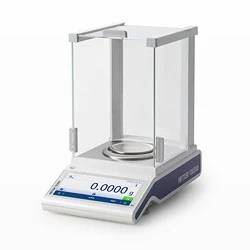Analytical Balance
What is an analytical balance?
Analytical
balance is a lab-instrument used to determine mass of any matter very precisely.
These analytical balances are very sensitive and expensive lab-instruments, and
also upon the accuracy and precision of analytical balance the accuracy of lab-analysis
result depends so handle these balances very carefully.
Generally used analytical
balances are balances with the capacity of 100 gram to 200 gram and the sensitivity
of 0.1 milligram to 0.001 milligram. For any quantitative chemical analysis there
is need of analytical balance for the weighing of sample for analysis and weighing
of reagents for solution preparation. Analytical balance pan used to put sample on
it is enclosed in a glass-fitted case, means analytical balance sensitivity
requires that it to be protected by the draft shield or enclosure.
Definition of Analytical Balance
Analytical
balance is a lab instrument with a scale to measure the mass to a high degree
of precision. Generally
used analytical balances are balances with the capacity of 100 gram to 200 gram
and the sensitivity of 0.1 milligram to 0.001 milligram.
Where are analytical balances used?
Analytical balances are used in labs so also known as ‘Lab Balances’. In labs analytical balances are used for quantitative analysis like for measuring of sample, preparation of standard solutions etc.How to weigh on an analytical balance?
These
are the following steps to start weighing operation on an analytical balance-
- Wear hand gloves.
- Open the door of balance and place the container on pan of analytical balance.
- Now, close the door of the analytical balance and wait for some time.
- After some time, value on balance display or scale get stabilizes and shows some weight.
- Now, press the tare button to get 0.0000 gram reading on display.
- Add the sample until the required weight.
- Now, close the door and wait for some time.
- After some time, value on balance display or scale get stabilizes, and shows some weight.
- Record the net weight.
- Clean the balance after use.
What is analytical balance uncertainty?
Analytical balance uncertainty is the margin of error in weighing, means when making measurements or weighing there is always an element of uncertainty in measurements or weighing. Determination of measurement uncertainty in analytical balance results is an integral part of the balance calibration.
Why should I calibrate my analytical balance?
Calibration of analytical balance is very necessary because balance calibration ensures that weighing balance is precise, correct, truthful, accurate, and satisfies different standards like ISO, GLP, and GMP. Calibration of analytical balances should be documented, as it specifies the quality of measurements. Documented calibration should be performed repeatedly, at some time intervals (like 3months+/-15days).
How should I calibrate my analytical balance?
You
should not calibrate your balance on your own, but it should be calibrated by
third party. Means, calibration of balance is performed by third party authorized
service technician. This third party authorized
service technician follow a standard procedure and utilizes some calibration
software to calibrate your analytical balance.
If you want to determine the minimum weight of your balance, you need to assess measurement uncertainty in the working environment.
What is the analytical balance minimum weight?
Generally minimum weight of analytical balance is not fixed, means it is different for different balances and it depends on different factors like performance of load cell, location of balance, and surrounding environment. Minimum weight is smallest weight that can be measured with accuracy. If we try to measure below this minimum weight, we get results higher relative measurement uncertainty than the required weighing accuracy. So, measurements below minimum weight cannot be trusted.If you want to determine the minimum weight of your balance, you need to assess measurement uncertainty in the working environment.
Analytical balance accuracy and precision – what is the difference and how to test them?
Precision
in balances refers to the closeness of two or more measurements to each other,
means if we measure 5gram sample and its display shows 5.0001 in 1st
time measurement, 5.0000 in 2nd time measurement, 4.9999 in 3rd
measurement, and 5.0000 in 4th measurements so all these results (5.0001,
5.0000, 4.9999, and 5.0000) are very close to each other.
Accuracy
in balances means how accurate result it gives so, Accuracy in balances refers
to the closeness of a measured value to a known value, and Accuracy in balances
is based on repeatability, readability, eccentricity and non-linearity.
Accuracy of analytical balance can be tested using.
- A traceable calibrated weight also known as external reference weight having a known mass. And these weights are calibrated by third party and come with documented proof.
- Accuracy of balance must be determined at its location of use.
Do you know?
What is Analytical Chemistry?
Analytical chemistry is all
about, what an analytical chemist does in an analytical chemistry lab. And simply
we can say that analytical chemistry is the branch of chemistry for qualitative
analysis and quantitative analysis of compounds and mixtures by using different
test methods and techniques like flame tests, chemical tests, precipitation,
titration, chromatography, spectroscopy, separation, microscopy etc.
Definition
of Analytical Chemistry- Analytical Chemistry is the branch of
chemistry deals with the study of material examination to separate out them
into different components and identifying all components and how much these
components present in material. There are different analytical methods and
techniques to perform these tasks... read more



Your info is Really Amazing with Impressive content. Excellent blog with an informative Concept.
ReplyDeleteAnalytical Balances
Urethral Swab
Nasopharyngeal Swab
Science Lab Equipment
Science Laboratory Supplies